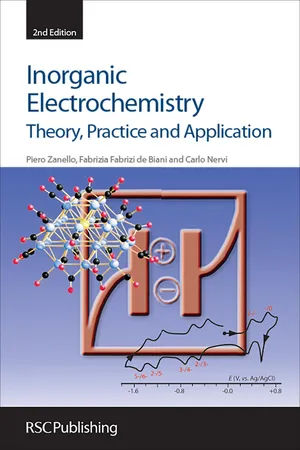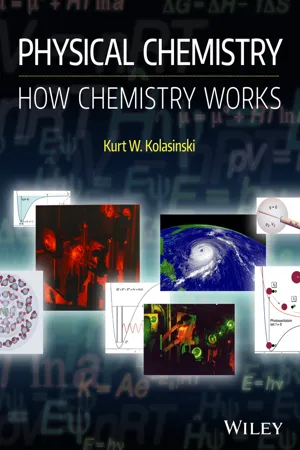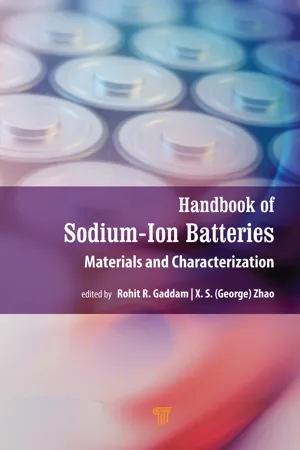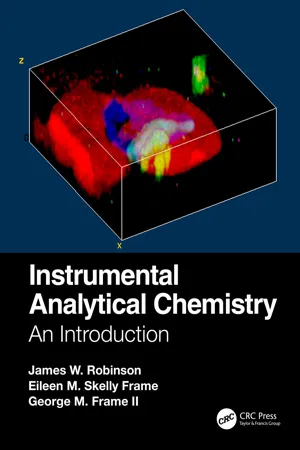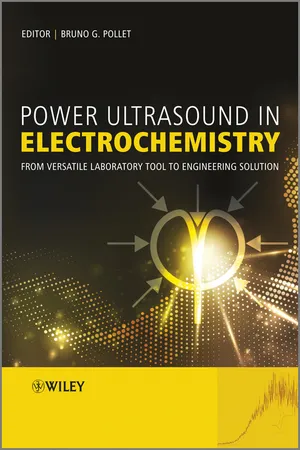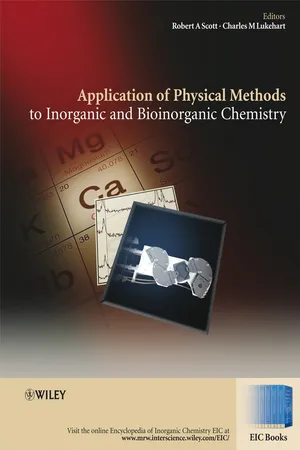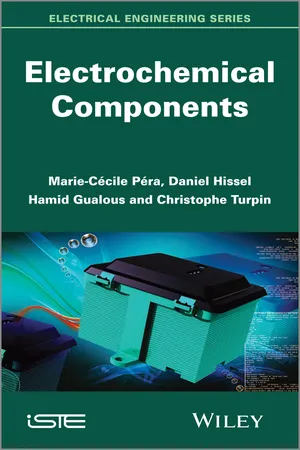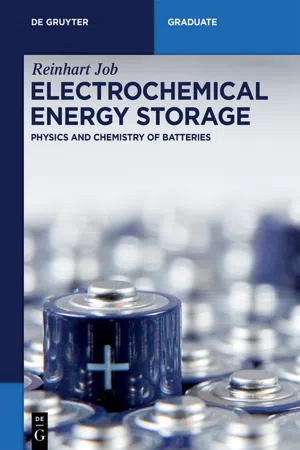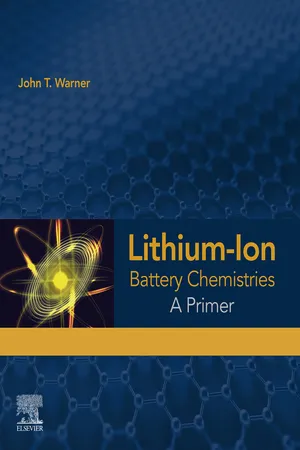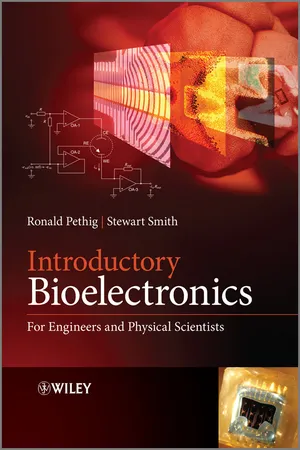Chemistry
Electrochemistry
Electrochemistry is the study of the relationship between chemical reactions and electricity. It involves the movement of electrons in chemical reactions, and the conversion of chemical energy into electrical energy, and vice versa. Key concepts in electrochemistry include redox reactions, electrolysis, and electrochemical cells, which have applications in batteries, corrosion prevention, and industrial processes.
Written by Perlego with AI-assistance
Related key terms
Related key terms
1 of 4
Related key terms
1 of 3
11 Key excerpts on "Electrochemistry"
- eBook - ePub
Inorganic Electrochemistry
Theory, Practice and Application
- Piero Zanello, Carlo Nervi, Fabrizia Fabrizi de Biani(Authors)
- 2019(Publication Date)
- Royal Society of Chemistry(Publisher)
Part 1:Basic Aspects of Electrochemistry
Passage contains an image CHAPTER 1 Fundamentals of Electrode Reactions
Electrochemistry is essentially based on the relationships between chemical changes and flows of electrons (i.e. the passage of electricity). In this connection it is well known that electron-transfer processes play an essential role in many physical, chemical and biological mechanisms and several such examples will be illustrated in the text. Perhaps in no other field of chemical reactivity can one look for and find so many relationships between theory and experimental measurements.Two disciplines cover the majority of the theoretical and practical aspects of the mechanisms through which electron transfers proceed: Electrochemistry and photochemistry. This book considers only mechanisms relating to Electrochemistry.1.1 ELECTRON-TRANSFER REACTIONS
In a purely formal manner the description of an electron-transfer event, such as the reduction in solution of Fe(III ) ion, can be written in two ways, depending on whether the reduction is operated by a chemical agent or by an electrode:- through a reducing agent (redox reaction in a homogeneous phase):
- through an electrode (redox reaction in a heterogeneous phase):
In both cases, the adopted symbolism only gives a picture of the overall process. In fact, mechanistically, the redox reactions (as with any other type of reaction) proceed by a series of intermediate steps involving phenomena such as: - eBook - ePub
Physical Chemistry
How Chemistry Works
- Kurt W. Kolasinski(Author)
- 2016(Publication Date)
- Wiley(Publisher)
A great deal of chemistry, particularly solution-phase and corrosion reactions, occurs by means of charge exchange. Electrons are swapped back and forth in at least one step of an electrochemical mechanism. This is in contrast to the ‘thermal’ chemistry of covalent bonds in which electron density is pushed around and rearranged but no free charge is generated or exchanged. Free charge is strongly influenced by electric fields, as is Electrochemistry. Because of this the application and measurement of voltages, currents and conductivities are intimately related to Electrochemistry. It leads to a whole new set of vocabulary and sign conventions separate from those used in thermal chemistry. The choices of signs are set in accord with the Stockholm convention of 1953.The commercial applications of Electrochemistry are immense. The production of aluminum as well as Cl2 and NaOH (in the chlor-alkali process) occur via electrolytic syntheses. The electrorefining of Cu and electroplating of Ag, Au or Cr all rely on Electrochemistry. That cars do not routinely rust out anymore is because of the successes in understanding the Electrochemistry of corrosion that has led to the coating of steel with anticorrosion layers. Batteries, whether rechargeable or single-use, take advantage of spontaneous electrochemical reactions to convert chemical into electrical energy, as do fuel cells. Photovoltaics and solar cells are intertwined with semiconductor Electrochemistry. Electrochemistry is also an extremely efficient and versatile tool for producing nanostructures, in particular, nanostructured semiconductors and oxides, as shown in Fig. 15.1 .Figure 15.1 TiO2 nanotubes produced by the electrochemical process perfected in the group of Patrik Schmuki.1 - eBook - ePub
Handbook of Sodium-Ion Batteries
Materials and Characterization
- George Zhao, Rohit R. Gaddam, George Zhao, Rohit R. Gaddam(Authors)
- 2023(Publication Date)
- Jenny Stanford Publishing(Publisher)
Chapter 2 Principles of Electrochemistry Nisha Garg, Venkatasailanathan Ramadesigan, and Sankara Sarma V. Tatiparti Department of Energy Science and Engineering, Indian Institute of Technology Bombay, Mumbai 400076, India [email protected]Electrochemistry is a branch of physical chemistry that studies the chemical changes that occur due to the flow of electrical current. The flow of current, caused by a random chemical reaction or the chemical reaction caused by an external electricity supply, is an example of an electrochemical reaction. Electrochemical processes are the basis for large-scale chemical and metallurgical production of materials, metallic corrosion, power sources, and industrial metal finishing. Batteries and fuel cells are prime examples of electrochemical devices that convert chemical energy into electrical energy. Primary and secondary batteries are the backbone of today’s engineering devices that require energy storage.Energy storage systems are fast emerging as an essential part of the evolving clean energy systems of the 21st century. Energy storage represents a huge economic opportunity and could help countries achieve their emission reduction targets by shifting to renewablebased generation. Most of the portable devices we see around us, such as laptops, mobile phones, watches, cars, and inverters, have one of these kinds of electrochemical storage systems. Therefore, it is the need of the hour to understand the basics of these electrochemical energy storage systems or specifically batteries. We discuss the underlying electrochemical principles of the working of batteries in this chapter. This understanding will eventually help us in designing better energy storage systems for future needs.2.1 Electrochemical Cells
Electrochemical cells contain two electrodes, called the anode and the cathode. The electrode where oxidation occurs is called the anode, and the cathode is where reduction takes place. Electrodes are usually made from conductive materials, including metals, semiconductors, and graphite. The electrolyte is filled between these two electrodes, which contains ions that can freely move. A porous separator usually separates the two electrodes. An electrochemical cell can be of two types: galvanic or voltaic cell and electrolytic cell. In the case of galvanic/voltaic cells, the decrease in free energy during the spontaneous redox chemical reaction is converted into electrical energy. On the other hand, in an electrolytic cell, a nonspontaneous chemical reaction is driven by an external source of current, thus converting electrical energy into chemical energy. - eBook - ePub
Understanding Molecules
Lectures on Chemistry for Physicists and Engineers
- Franco Battaglia, Thomas F. George(Authors)
- 2018(Publication Date)
- CRC Press(Publisher)
14 ElectrochemistryIn previous chapters, upon treating the energetic features of chemical reactions, we have seen that they are generally accompanied by heat exchanges (heat production in exothermic reactions and heat absorption in endothermic reactions). Electrochemistry is concerned with reactions proceeding with the production or consumption of electric energy: clearly, at least from a thermodynamic point of view, electrochemical reactions differ from ordinary chemical reactions so far considered.Let us consider, for example, the reactionZ n + Cu→ Z2 +n+ C u .2 +( 14.1 )This entails a transfer of electrons from zinc to copper. However, when it occurs as an ordinary chemical reaction, the reactants, via some suitable, possibly multi-step, collision process, bring themselves into intimate contact with each other. Thus, the path travelled by the electrons is on the order of the interatomic distances between the colliding species; moreover, collisions occur in a chaotic manner, and only some of these have sufficient energy to either overcome the potential barrier (activation energy) pertaining to the process or allow effective electron tunneling.It is clear that, as long a reaction of the type (14.1 ) proceeds as just described, it cannot be used to produce an electric current, since the energy produced is in the form of heat. The desired electric current does require a transfer of electrons, but it must occur with a non-chaotic charge flux, guided along a given direction, and along a path entailing macroscopic distances, much larger than the typical intermolecular distances between the colliding reactants. In order for something like this to be possible, it is first necessary that the reactants be kept spatially separated from each other; moreover, the reaction must occur in an experimental arrangement ensuring a continuous flux of charges (namely the desired electric current). Such an experimental arrangement is called an electrochemical system : it is a Galvanic cell if electric current is produced by a chemical reaction, and an electrolytic cell - eBook - ePub
Instrumental Analytical Chemistry
An Introduction
- James W. Robinson, Eileen M. Skelly Frame, George M. Frame II(Authors)
- 2021(Publication Date)
- CRC Press(Publisher)
Electroanalytical Chemistry 13 DOI: 10.1201/b21879-13 Electrochemistry is the area of chemistry that studies the interconversion of chemical energy and electrical energy. Electroanalytical chemistry is the use of electrochemical techniques to characterize a sample. The original analytical applications of Electrochemistry, electrogravimetry, and polarography, were for the quantitative determination of trace metals in aqueous solutions. The latter method was reliable and sensitive enough to detect concentrations as low as 1 ppm of many metals. Since that time, many different types of electrochemical techniques have evolved, each useful for particular applications in organic, inorganic, and biochemical analyses. A species that undergoes reduction or oxidation upon application of a voltage or current is known as an electroactive species. Electroactive species in general may be solvated or complexed, ions or molecules, in aqueous or nonaqueous solvents and even in films. Electrochemical methods are now used not only for trace metal ion analyses, but also for the analysis of organic compounds, for continuous process analysis, and for studying the chemical reactions within a single living cell. Applications have been developed that are suited for quality control of product streams in industry, in vivo monitoring, materials characterization, and pharmaceutical and biochemical studies, to mention a few of the myriad applications. Concentrations as low as 1 ppm can be determined - eBook - ePub
Power Ultrasound in Electrochemistry
From Versatile Laboratory Tool to Engineering Solution
- Bruno Pollet(Author)
- 2012(Publication Date)
- Wiley(Publisher)
Introduction to Electrochemistry Bruno G. Pollet and Oliver J. Curnick I.1 IntroductionThis summary introduces some fundamental aspects of Electrochemistry, explaining the various electrochemical phenomena occurring at the electrode surface when a potential is applied across it. For this purpose, electrode kinetic and mass-transport parameters will be defined in detail.I.2 Principles of ElectrochemistryAll chemical interactions involve the interaction of electrons at the atomic or molecular level, so that, in a sense, all chemistry is Electrochemistry. The fundamental process in Electrochemistry is the transfer of electrons between the surface of the electrode and the molecules of a chemical species in the region adjacent to this surface. The nature of this region has a significant effect on the current response, thus it is very important to have some idea about its structure.Several models have been proposed for the interfacial region. In the simplest model, the charge on the electrode is balanced by a layer of solvated ions of opposite charge held at the electrode surface by coulombic attraction. This region is called the ‘electric double layer’ [1]. A consequence of this arrangement is that the potential drop between the electrode and the solution occurs across an interfacial region which is a few nanometers thick, leading to a high electric field.Other models have also shown that the interfacial region can be viewed as two layers of equal and opposite charge separated by a dielectric material (Figure I.1 ). The first region consists of adsorbed solvent molecules and anions and is defined as the inner Helmholtz plane (IHP). The next layer is defined as the outer Helmholtz plane (OHP) and consists of solvated cations held in this plane by coulombic attraction extending into the diffusion layer where there is competition between the ordering effect of coulombic attraction and disordering of thermal motion. In other words, any electrode immersed in an electrolyte can be modelled as a resistor and capacitor connected in series (an rC system) (by analogy with electrical circuits) where the double layer act as a capacitor C and the ionic medium as a resistor r . The product rC - Robert A. Scott, Charles M. Lukehart, Robert A. Scott, Charles M. Lukehart(Authors)
- 2013(Publication Date)
- Wiley-Interscience(Publisher)
The technical background will be covered for the various electroanalytical techniques, followed by applications to inorganic systems, including practical concerns and data interpretation. 2 TECHNICAL BACKGROUND 2.1 Electrode Reaction Fundamentals To evaluate reactions that take place at the electrode at a fundamental level, we first consider a thermodynamic perspective. Any thermodynamic analysis of a chemical reaction begins with the Gibbs free energy equation (1), 1 which relates cell potentials directly to free energy (1) where Δ G ° is the standard free energy change, n is the number of electrons, F is Faraday’s constant (96 485 C mol −1) 4 the total charge of 1 mole of electrons, and E° is the standard potential. The application of thermodynamics to Electrochemistry considers systems that are at equilibrium. As such reversibility, specifically thermodynamic reversibility, is integral in evaluating cell potentials mathematically. If a process is thermodynamically reversible, or nernstian, the Nernst equation (2) 1 can be used to relate the concentrations of two species, O (oxidized species) and R (reduced species) (equation 3), to potential, E (2) where E is the potential at nonstandard conditions, R is the gas constant (8.314 J K −1 mol −1), 4 and T is temperature in K. The units on the second term yield J C −1 or V. (3) The reaction in equation (3), the addition of electrons, is a reduction, and the opposite reaction, the removal of electrons, is an oxidation, and the concentration of species O and R are that of the bulk. When examining an electrochemical reaction of an analyte in solution at the surface of an electrode, mass transport and the kinetics of electron transfer at a solid/liquid interface become important considerations. The study of Electrochemistry involves the addition and removal of electrons. In inorganic molecules this process can result in bond making/breaking, typically involving a ligand covalently bound to a metal- eBook - ePub
- Marie-Cécile Pera, Daniel Hissel, Hamid Gualous, Christophe Turpin, Marie-Cécile Pera, Daniel Hissel, Hamid Gualous, Christophe Turpin(Authors)
- 2013(Publication Date)
- Wiley-ISTE(Publisher)
Chapter 1
Basic Concepts of Electrochemistry used in Electrical Engineering
1.1. Introduction
The aim of this chapter is to lay down some basic concepts of Electrochemistry which are necessary in order to understand the behavior of the electrochemical components described in this book. For a detailed presentation, the reader could be helped by referring to specialized books such as [DIA 96; LEF 09].1.2. Brief description and principles of operation of electrochemical components
1.2.1. Principle of operation [TUR 08]
Every electrochemical component is made up of a positive electrode and a negative electrode, separated by an electrolyte which may be either liquid or solid (see Figure 1.1 ). Conventionally, with generators, it is the positive electrode from which the current originates when functioning in generator mode.Generally speaking, an electrochemical component can operate as an electric generator or an electric load, or both if it has reversible function.Figure 1.1. Principle of operation of electrochemical components [TUR 08]In short, the component is the site of an oxidation/reduction reaction which involves two “redox” pairs. More specifically, each electrode is the site of oxidation (loss of electrons) or reduction (gain of electrons) depending on the direction of the current flowing through the component (Figure 1.1e ). The n electrons released by the oxidation reaction occurring in an electrode circulate from that electrode to the other via the external electrical circuit. Simultaneously to this circulation of electrons, and in the same direction, the n ions from the electrode being oxidized circulate toward the other electrode through the electrolyte. Thus, the reduction reaction is able to take place on the other electrode.The electrodes need to be good electrical conductors. The electrolyte has to be a good ion conductor and a good electron insulator, in order to avoid any short-circuits between the two electrodes. In the case of a liquid electrolyte, a separator is usually used to electrically insulate the two electrodes. The reactions consume reactants and form products, which have to be respectively brought to and evacuated from the reaction area. - eBook - ePub
Electrochemical Energy Storage
Physics and Chemistry of Batteries
- Reinhart Job(Author)
- 2020(Publication Date)
- De Gruyter(Publisher)
On a macroscopic level, chemical energy describes the type of energy related to the electromagnetic forces in atoms and molecules, and it affects chemical reactions. Here, the concept of a chemical energy includes also the kinetic and potential energies of electrons and electromagnetic interactions between electrons and the atomic nucleus. With this regard, chemical energy is an internal energy and chemical reactions that absorb or release energy can be characterized by a change of the internal energy U in accordance with the thermodynamic eq. (2.10). One can state that in the scientific community – especially in chemical sciences – the term chemical energy is usually not used, since only under well-defined conditions, it can be exactly defined and in this case, specific notations are used. For instance, the chemical energy that is released due to a combustion reaction at constant pressure is called heat of combustion or combustion enthalpy. Before we put the focus on a first example of a galvanic cell in Section 3.5.2, we briefly discuss a very simple model that illustrates electrochemical reactions in a very comprehensible way. 3.5.1 Electrochemical reactions Chemical and electrochemical reactions can be described in a very simple and catchy way. In the following brief explanations, we first look at chemical reactions and subsequently extend our angle of view to the electrochemical reactions. Chemical reactions can proceed in very different and complex ways. One can say that the morphologies of chemical reactions have many different characteristics. We start a very simple case with two substances A and B (i.e., the educts). We suppose that A and B are metallic materials. The educts are brought in contact to undergo a chemical reaction and form a new substance C (i.e., the product) that is also a metallic material - eBook - ePub
Lithium-Ion Battery Chemistries
A Primer
- John T. Warner(Author)
- 2019(Publication Date)
- Elsevier(Publisher)
Negatively charged anions and the positively charged cations are held together by an electrostatic force, known as ionic bonding. Metallic bonding occurs when atoms lose their valence electrons forming a negatively charged electron gas which will attract and hold together positive atoms. Covalent bonding occurs when two atoms share valence electrons. Van der Waals is an electrostatic attraction of molecules but it is the weakest of these forms of bonding (Hosford, 2013). 2.3 Electrochemistry The combination of chemistry and electricity gives us the field of Electrochemistry which has been defined as involving looking at the interactions between different materials that conduct electricity (Lefrou et al., 2012, p. 22). Electrochemistry tends to focus on the study of the electrical interface zones where two materials with different levels of conduction meet. To put it simply, think of this as the place where the surfaces of different materials touch—where the electrolyte touches the cathode or anode materials, and where the cathode or anode touches the current collectors. These regions are typically only a few nanometers thick, but it is where the magic happens. These are the interface zones where the ions and electrons transition from one material to the other. Electrochemistry is also heavily concerned with the study of the reduction and oxidation transformations that occur on the atomic scale and which we have learned to control, manage, and use through the use of a variety of electronic devices. Remember when we described batteries as devices that store chemicals that can react to store or generate electricity? The redox reactions are the chemical reactions we were referring to there (Lefrou et al., 2012 ; Salomon, 2011). In simple terms oxidation takes place when an element loses one or more electrons and an element is said to have been reduced when it gains one or more electrons - eBook - ePub
Introductory Bioelectronics
For Engineers and Physical Scientists
- Ronald R. Pethig, Stewart Smith(Authors)
- 2012(Publication Date)
- Wiley(Publisher)
Chapter 5 Electrochemical Principles and Electrode Reactions5.1 Chapter Overview
Many biosensors operate by detecting or controlling electrochemical reactions involving the target analyte itself, or an electroactive chemical product of the analyte. The reactions occur at an electrode (variously termed the working, sensing or indicator electrode) whose main function is to electrochemically interact with chemical species close to the electrode surface by way of an electron transfer reaction. The reaction rate and type can be controlled by changing the potential of the electrode, with respect to a reference electrode, and is often quantitatively analysed by applying a constant or time-varying potential change and measuring the electrode current response, or alternatively imposing a current and measuring the response of the electrode potential. The basic principles of Electrochemistry and electron transfer reactions at electrode surfaces are presented in this chapter, and will serve to introduce concepts covered in the following chapters on biosensors and instrumentation.After reading this chapter readers will gain a basic understanding of:i. electron transfer and redox reactions at electrode-solution interfaces;ii. anodic and cathodic reactions in electrochemical and electrolytic cells;iii. the concept of the standard reduction potential;iv. the application of the Nernst equation for determining the relationship between an electrode potential and the relative concentrations of the reactants in a redox couple;v. the theory and application of reference electrodes;vi. the basics of amperometry and cyclic voltammetry;vii. Electrochemical Impedance Spectroscopy.5.2 Introduction
Electrochemistry is the study of electron transfer processes that normally occur at electrode-solution interfaces, in what are termed redox reactions. The term redox reaction is shorthand for reduction-oxidation
Index pages curate the most relevant extracts from our library of academic textbooks. They’ve been created using an in-house natural language model (NLM), each adding context and meaning to key research topics.
Explore more topic indexes
Explore more topic indexes
1 of 6
Explore more topic indexes
1 of 4
